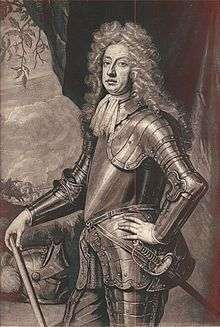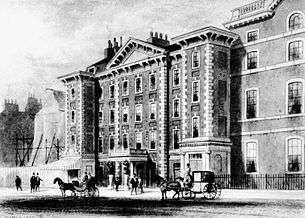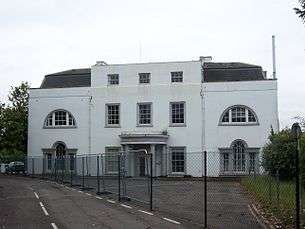Meinhardt Schomberg, 3rd Duke of Schomberg
| Meinhardt Schomberg, 3rd Duke of Schomberg | |
|---|---|
 Meinhardt Schomberg, 3rd Duke of Schomberg | |
| Born |
30 June 1641 Cologne, Germany |
| Died |
16 July 1719 (aged 78) Hillingdon, London, England |
| Allegiance |
|
| Service/branch |
|
| Years of service |
1689-1707 (England) 1707-1719 (Great Britain) |
| Rank | General |
| Battles/wars |
Franco-Dutch War Williamite War in Ireland War of the Spanish Succession |
| Awards | Knight of the Garter |

Meinhardt Schomberg, 3rd Duke of Schomberg, 1st Duke of Leinster, KG (30 June 1641 – 16 July [O.S. 5 July] 1719), was a general in the service of Willem, Prince of Orange and Stadtholder of Holland, later King William III of England. He fought in the Franco-Dutch War, then played a crucial role at the Battle of the Boyne in July 1690 during the Williamite War in Ireland and finally commanded the British troops deployed to Portugal during the War of the Spanish Succession.
Military career
Born the son of Frederick Schomberg, 1st Duke of Schomberg (who was of Huguenot descent), and Johanna Elizabeth de Schomberg (née von Schönberg), Meinhardt Schomberg joined his father in the service of the English Expeditionary brigade to Portugal and served as a lieutenant-colonel and then as a colonel.[1] He then settled in La Rochelle with his father and became a French subject.[1] He attained the rank of brigadier and, afterwards, maréchal de camp (major general), during the Franco-Dutch War in 1678.[1] He fought under Marshal François de Créquy at the Battle of Kochersburg in October 1677, the Battle of Freiburg im Breisgau on 14 November 1677, at the Battle of Rheinfelden in July 1678 and at the Battle of Kinzing later that month, before serving under Frederick William, Elector of Brandenburg as a general of cavalry.[1]
He travelled to England in Spring 1689 and was made colonel of Lord Cavendish's Regiment of Horse on 10 April 1690[2] and commissioned a general of the horse on 19 April 1690.[1]
Frederick Schomberg was second in command of William's army at the Battle of the Boyne in July 1690 during the Williamite War in Ireland.[3] Meanwhile, Meinhardt Schomberg commanded the right wing of William's army during the battle and led the crucial crossing of the River Boyne at Roughgrange near Rosnaree[4] on the Jacobites' flank, the turning point in the confrontation, despite a gallant defence by Sir Neil O'Neill, a Jacobite general.[5] Schomberg then engaged in a pursuit of the retreating troops towards Duleek:[5] there were no casualties amongst his regiment's soldiers.[2] Schomberg's father died during the latter stages of the Battle which resulted in a decisive Williamite victory.[2]
Meinhardt Schomberg was created Duke of Leinster for his part in the Battle on 30 June 1690[6] and, after taking part in the abortive Siege of Limerick in August 1690, he became a British subject through naturalization by Act of Parliament on 25 April 1691.[7] From May 1691 he was also made Commander-in-Chief of the Forces during the King's travels in Flanders.[6] In Spring 1693 Schomberg was placed in command of the abortive descent on Saint-Malo and in October 1693 he inherited the title of Duke of Schomberg following the death of his younger brother Charles Schomberg at the Battle of Marsaglia.[1] In 1698 he moved into Schomberg House, a new mansion specially commissioned for him on the south side of Pall Mall, London.[8]
In 1703, he was created Knight of the Garter[9] and Queen Anne appointed him Commander-in-Chief of the British forces sent to Portugal for the War of the Spanish Succession.[6] Once in Portugal Schomberg was ineffective, simply allowing the Spanish General Tserclaes de Tilly to pass by unchallenged.[1] Moreover, Schomberg had a dreadful temper which attracted universal disgust: neither Peter II, King of Portugal, nor Charles, claimant to the throne of Spain, were prepared to accept his turbulent behaviour and he was sent home in disgrace.[6]
Meinhardt Schomberg had an interest in naval matters and registered a patent concerning inspecting the fishing for wrecks.[10] He commissioned the construction of Hillingdon House in 1717 as his hunting lodge[11] and died there on 16 July [O.S. 5 July] 1719.[1] He had no male issue so all of his titles (Duke of Schomberg, Duke of Leinster, Marquess of Harwich, Earl of Brentford, Earl of Bangor, Baron Teyes and Count of Mértola)[9] except Count of Mértola died with him.[6]
The town of Schomberg, Ontario was renamed to commemorate the 3rd Duke of Schomberg in 1862.[12]
Family

On 3 August 1667, Schomberg married Piedmontese Barbara Luisa Rizzi: the couple did not have any children.[1] On 4 January 1682 Schomberg married Raugräfin Karoline Elisabeth (a daughter of Charles I Louis, Elector Palatine) and together they had four children:[1]
- Charles Louis Schomberg, Marquess of Harwich (15 December 1683 – 14 October 1713), died from tuberculosis.[13]
- Lady Caroline Schomberg (1686 – 18 June 1710)
- Lady Frederica Schomberg (c. 1688–1751)
- Lady Mary Schomberg (bap. 16 March 1692 – 29 April 1762)
References
- 1 2 3 4 5 6 7 8 9 10 "Meinhardt Schomberg, 3rd Duke of Schomberg". Oxford Dictionary of National Biography. Retrieved 13 May 2012.
- 1 2 3 "7th Dragoon Guards". British Empire. Retrieved 13 May 2012.
- ↑ "Schomberg House". The Grand Orange Lodge of Ireland. Retrieved 13 May 2012.
- ↑ "Rosnaree: history". Retrieved 13 May 2012.
- 1 2 "The Battle of the Boyne". Electric Scotland. Retrieved 13 May 2012.
- 1 2 3 4 5 Noble, p.180
- ↑ Cruickshank, p.498
- ↑ "Schomberg House, Pall Mall, Westminster, Greater London". Heritage Explorer. Retrieved 13 May 2012.
- 1 2 "Knights of the Garter at the accession of George I in 1714". European Heraldry. Retrieved 13 May 2012.
- ↑ Shaw, p.509-518
- ↑ Sherwood, p.97
- ↑ "Schomberg". Rural Routes. Retrieved 13 May 2012.
- ↑ "No. 5162". The London Gazette. 6 October 1713. p. 2.
Sources
- Cruickshank, Eveline (2002). The House of Commons, 1690-1715, Volume 1. Cambridge. ISBN 0 521 77221 4.
- Noble, Mark (1806). A biographical history of England, from the Revolution to the end of George I's reign.
- Shaw, William (1934). Index of persons and Places: S', Calendar of Treasury Books, Volume 14: 1698-1699.
- Sherwood, Philip (2007). Around Uxbridge Past & Present. Stroud: Sutton Publishing. ISBN 978-0-7509-4794-7.
| Military offices | ||
|---|---|---|
| Preceded by The Earl of Marlborough |
Commander-in-Chief of the Forces 1691 |
Vacant Title next held by The Duke of Marlborough |
| Peerage of Ireland | ||
| Preceded by New Creation |
Duke of Leinster 1691–1719 |
Succeeded by Extinct |
| Peerage of England | ||
| Preceded by Charles Schomberg |
Duke of Schomberg 1693–1719 |
Succeeded by Extinct |
| Titles of nobility | ||
| Preceded by Frederick Schomberg |
Count of Mértola 1690–1719 |
Succeeded by Frederica Darcy |
